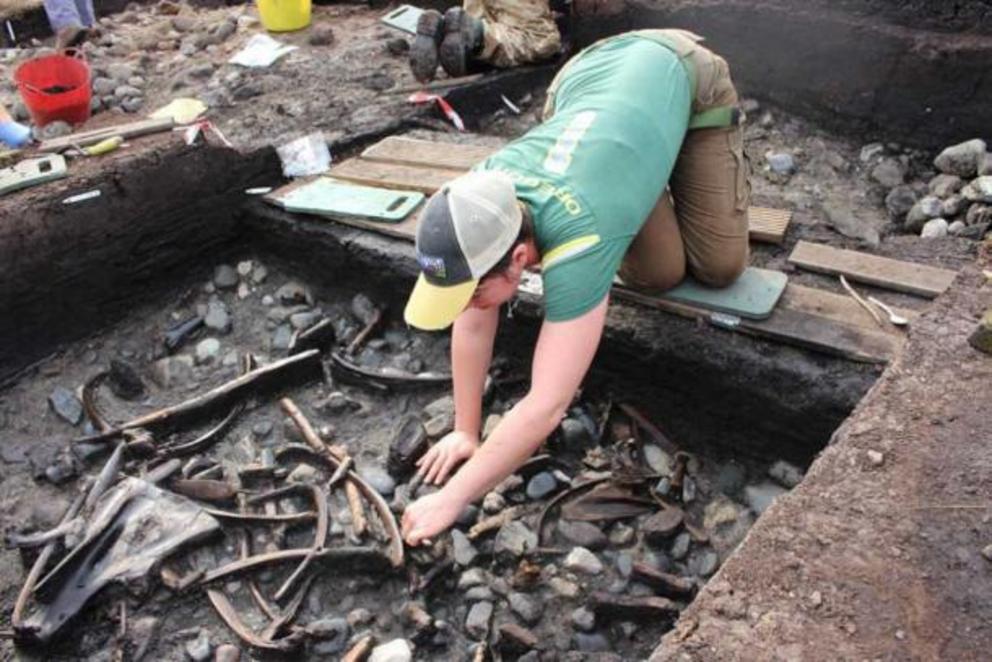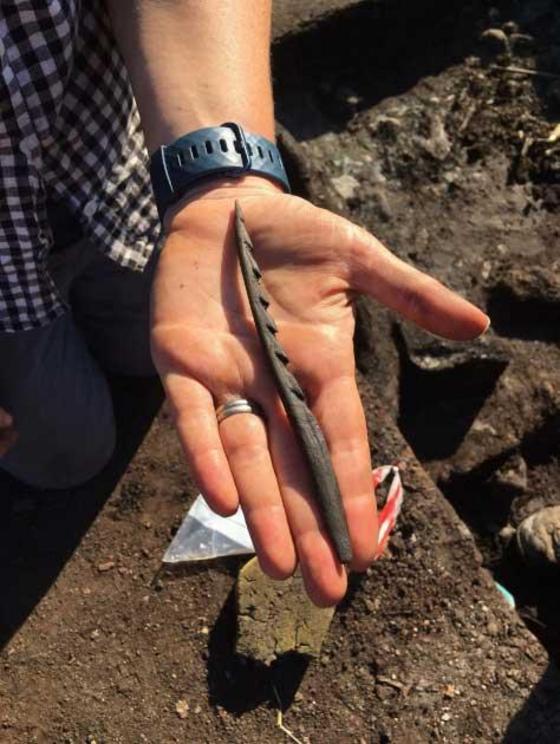Harmony with nature revealed at 10,500-year-old hunter-gatherer site in Yorkshire
Top image: Representational image of hunter-gatherer in nature.
At a site near Scarborough in North Yorkshire , the exceptionally well-preserved remains of a small settlement dating back 10,500 years have been found which was once inhabited by a group of hunter-gatherers. The settlement revealed animal bones, tools and weapons (made of bone, antler, and stone), along with rare evidences of woodworking.
“It is so rare to find material this old in such good condition,” said Dr. Nick Overton from The University of Manchester. “The Mesolithic in Britain was before the introduction of pottery or metals, so finding organic remains like bone, antler and wood, which are usually not preserved, are incredibly important in helping us to reconstruct peoples’ lives.”
 Excavations of a 10,500-year-old hunter-gatherer site near Scarborough have revealed details about the relationship of these ancient peoples and their surrounding environment.
Excavations of a 10,500-year-old hunter-gatherer site near Scarborough have revealed details about the relationship of these ancient peoples and their surrounding environment.
Examining 10,500-Year-Old Hunter-Gatherer Site at Scarborough
The Yorkshire site had been under the joint examination of archaeologists from the University of Chester and University of Manchester, according to a press release . Dating back to the Mesolithic (Middle Stone Age) period, the hunter-gatherer site was originally on the shore of island in an ancient lake. Over the many thousand years since, the lake slowly filled in with thick deposits of peat, gradually burying and preserving the site.
There is often an image of hunter-gatherers who were constantly on the brink of starvation, moving from place to place in search of food and shelter. The advent of settled agriculture is seen as the birth of a stable and safe lifestyle. In the case of the hunter-gatherers at this site, there is nothing further from the truth.
Inhabiting a group of rich ecosystems and habitats, they moved from site to site, decorating objects, disposing of animal remains in an effective manner, and leaving behind important evidence. Some of the evidence displayed a set of rules of disposal, showing an innate understanding of and with nature.
 A barbed antler point unearthed at the hunter-gatherer site in Scarborough.
A barbed antler point unearthed at the hunter-gatherer site in Scarborough.
Evidence of Harmonious Relationship with Nature at the Hunter-Gatherer Site
Their acute understanding of the seasons, the behaviours of organisms around them, both animate and inanimate, show a symbiotic relationship with nature, where struggling to survive was not on the agenda, according to a BBC report. A wide range of animals from a number of habitats around the lake were hunted – large mammals like elk and red deer, with smaller mammals like beavers and water birds. Hunted animals would be butchered and their parts were intentionally deposited into wetlands in and around the site.
In fact, researchers are very curious about how this rich landscape was used by early hunter-gatherers, and what effect they had on the environment. Modern humans and their relationship with the environment is well-documented (and catastrophic), but this was obviously not the case with our ancient ancestors.
“We know from research carried out at other sites around the lake, that these human communities were deliberately managing and manipulating wild plant communities,” explained Dr. Barry Taylor from the University of Chester, who was co-leading the dig at the hunter-gatherer site. “As we do more work on this site, we hope to show in more detail how humans were altering the composition of this environment thousands of years before the introduction of agriculture into Britain.”
 Artifacts discovered on a lake bed at the hunter-gather site in Scarborough.
Artifacts discovered on a lake bed at the hunter-gather site in Scarborough.
The Arrival of Hunter-Gatherers to Britain
The first humans arrived in Britain some 900,000 years ago, during the tough conditions of the Ice Age. Highly skilled adapters and survivalists, they lived in small, closely-knit family groups. Gifted tool makers, they were able to make axes and tools from flint, wood and bone found in the surrounding landscape for hunting animals and preparing food.
Around 40,000 years ago, modern homo sapiens began arriving in the UK, in the depths of the last Ice Age. Some 25,000 to 28,000 years after this, these modern homo sapiens began practicing settled agriculture, clearing forests and beginning a sedentary lifestyle. This was aided and enabled by the waning of the Ice Age , which led to warmer temperatures globally and cleared ice sheets across the globe.
 A decorated antler point found at the hunter-gather site in Scarborough.
A decorated antler point found at the hunter-gather site in Scarborough.
This dig is part of the celebrated Digging for Britain BBC docuseries, featuring on the 5th episode of the newest season , which is slated to be broadcasted on the 5th of February next month. The project is co-directed by Dr. Barry Taylor and Dr. Amy Gray Jones from the University of Chester, and Dr. Nick Overton from the University of Manchester.
The project received financial support from the Royal Archaeological Institute, the Prehistoric Society and the Scarborough Archaeological and Historical Society, and took place with the help of landowner Sidney Craggs, students and graduates from the Universities of Chester and Manchester, and volunteers from the Scarborough Archaeological and Historical Society.
For full references please use source link below.

